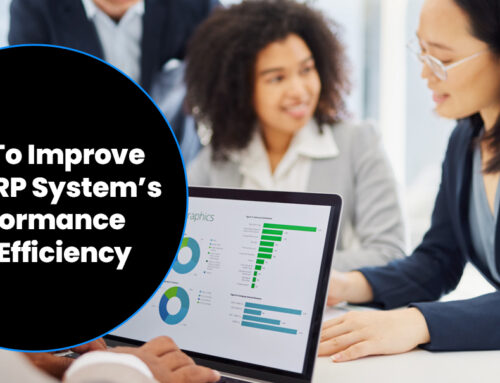
Enterprise resource planning (ERP) platforms typically include modules for virtually every company department and division. With such a diverse variety of user types — and potentially, thousands of users on a given platform — it should be no surprise that ERP implementation feels like a daunting task. But there are some measures you can take to avoid ERP implementation failure.
Tip #1 – Develop an ERP Implementation Plan
It sounds simple, but a surprising number of organizations wander into the ERP implementation with little direction. You need a clear, concise plan to implement an ERP platform. This software platform will serve as the centralized digital core of your company; as such, extensive planning is critical to ERP implementation success.
Pull in representatives from all of the divisions and departments that will be using the ERP platform to create an implementation task force. Together, you should create a detailed plan for the rollout process. (Hint: a phased rollout is typically the best strategy!) Work to identify potential challenges and roadblocks. Determine the process and order for the changeover that will occur as you switch from your old software systems to your new ERP platform. Create a clear list of expectations and KPIs for the implementation process and the time immediately after rollout occurs. Develop contingency and rollback plans in the event that something goes off the rails. Address the inevitable downtime and reduced productivity that may result during the implementation phase. Remember to discuss training and how you can achieve your training goals while still maintaining acceptable productivity levels.
Tip #2 – Create a Solid Data Migration Plan
Your data is one of your company’s most valuable assets. An ERP implementation entails migrating data from multiple systems and platforms. This process can get messy in very short order, resulting in nothing short of an operational shutdown in the most disastrous of cases. Thankfully there are ways companies can make data migration easier.
Data integrity is critical. You cannot risk a data scramble — or worse, data loss — due to haste or oversight. Some organizations may have data privacy-related burdens to consider as well.
Take the time to craft a detailed, step-by-step data migration and data handling plan. Plan for the worst-case scenario with backups and a comprehensive contingency and/or rollback plan.
Tip #3 – Invest in Training Sessions from the Experts
There are some companies that will invest significant sums of money on the development of a custom ERP platform, only to attempt much of the implementation and rollout on their own. That is — quite simply — a bad idea that positions an organization for a rocky start with their new enterprise software.
Invest the time and money in training sessions with the experts. Any reputable software development company will provide support for ERP implementation and rollout, offering training sessions to the company’s users.
Proper training will ensure that your users can leverage the ERP platform’s many features and functionalities to the maximum benefit from day one. What’s more, comprehensive training will reduce user stress levels over the new software, while simultaneously minimizing downtime. Training is one investment that will be well worth the time and effort.
Tip #4 – Assign Superusers for the Training Process and Beyond
Hiring a team of ERP professionals known as superusers plays an essential role during the ERP training process and in the days and weeks after rollout occurs. A superuser is a highly-trained user, typically with full admin privileges. These individuals undergo intensive training in advance of all others, achieving a high level of mastery over the new ERP platform and its many functions.
Superusers are available to field questions and offer extra support to their colleagues during the formal ERP training sessions. Additional questions and uncertainties always tend to arise when users leave the training room and begin to put the software through its paces. The superusers serve as a valuable resource during this time, providing support once the training sessions have ended.
There should be at least one superuser available per shift in each department or division. This way, there is a highly-trained team member available at all times, even after the software development company’s training team has departed.
It is usually best to select individuals who are already in a leadership role since a superuser must feel comfortable leading their colleagues. They should exude a sense of confidence too, as this helps boost morale amongst colleagues who may feel stressed and uncertain during the ERP implementation process.
Tip #5 – Remember to Address the User Stress
An ERP implementation and rollout process is stressful, no matter how much training or preparation the users receive. The goal, as an organization, must be to minimize that stress as much as possible, keeping morale and spirits high throughout the process. It’s easy to focus on the technical aspects of system changeovers and integrations, but that matters little if your users feel overwhelmed and go into shutdown mode. You want to avoid a scenario where users feel as though they’ve had the digital rug pulled out from under them as they transition from one platform to the new ERP system.
Formal training and offering support via superusers are two great strategies for avoiding ERP implementation failure. But you may need to go a bit further with incentives and other additional measures to help ease tensions. Gamification is one effective strategy. Develop games or contests centered around ERP platform usage or job performance to help inspire some fun competition.
Organizations may also opt to offer some options for decompression. For instance, you might call in a team of massage therapists and manicurists to provide some free lunchtime pampering to employees during implementation week. Measures such as these can make a huge difference in the user experience and overall morale levels during a potentially stressful time. Better morale translates into better focus; better focus means a smoother and more efficient ERP implementation.
Tip #6 – Continually Gather User Feedback During the ERP Implementation Process
Despite lots of planning and consideration, you may ultimately find that your ERP implementation plan contains some flaws. Don’t be compelled to follow a flawed plan just for the sake of sticking to a plan. You must be prepared to adapt along the way to avoid ERP implementation failure.
Feedback is critical during the ERP implementation process. You should be gathering feedback on a continual basis as you rollout your new enterprise software platform.
A simple Google form can be used to solicit ideas, comments, and complaints from end-users and others. In fact, everyone who is involved in the ERP implementation process should be encouraged to provide feedback on a daily basis. This may seem excessive, but these insights can prove extremely valuable, allowing you to make midstream improvements to the implementation process.
The implementation task force should be meeting daily during the actual implementation phase to address this feedback, making any necessary adjustments in response.
Notably, you should solicit feedback on more than just the actual ERP implementation and rollout; seek input on the actual software platform too. This places you in an ideal position to make improvements and expansions in a subsequent ERP development phase.
An ERP implementation is an exciting yet stressful time. You’re finally about to see the benefits of that shiny new enterprise software platform, but first, you need to get over that last hill of implementation and rollout. At Cox-Little, we are very experienced with the many challenges that your organization may encounter during ERP implementation. Contact the expert team at Cox-Little to discuss your enterprise software implementation and we’ll help you try and avoid ERP implementation failure.





